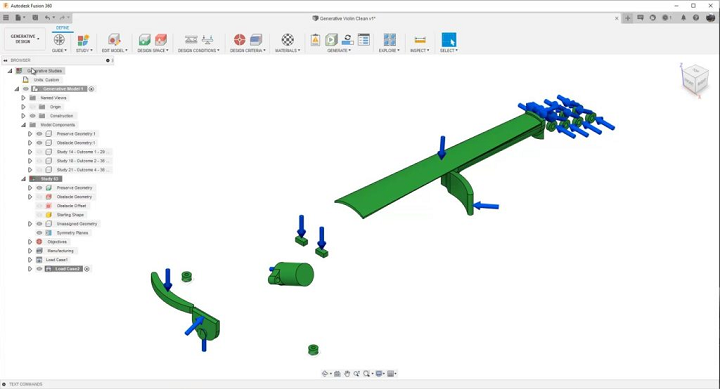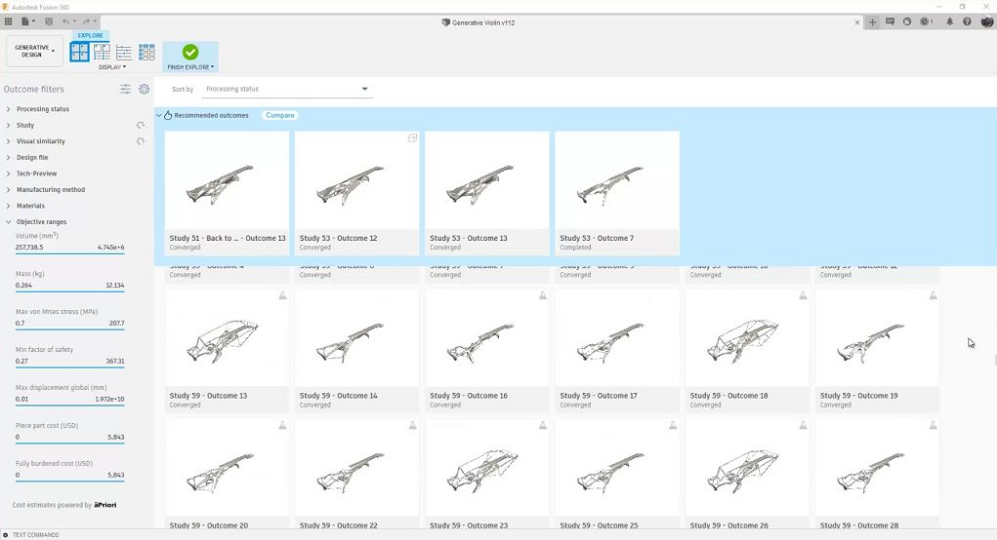It’s true, 3D printing and generative design can make beautiful music together…just look at the electric violin recently created by Autodesk and luthier (violin maker) Kevin Baslé! Electric violins, while built by hand sometimes, are most often mass-produced, but Baslé, an artist who has made plenty custom acoustic and electric violins throughout his career, wanted to develop a new manufacturing process for the instrument.
“We began to think about modeling an electric violin using AI, which was unproven in the violin industry. It had to function as a musical instrument, of course, but the design could be completely different. Something we had never thought of before,” Baslé said.
Starting as a joiner and carpenter before following his love of music to the rare craft of violin-making, Baslé worked with engineers at the Autodesk Technology Center in Birmingham to design and build the GD Violin. Violins have been around for many, many years, and as manufacturers continue to innovate, the design of the string instrument has begun to change. Nowadays, electric violins are often made out of acrylic, carbon fiber, and plastics, and we have seen 3D printed violins before, both acoustic and electric. But Baslé wanted to use traditional wood, paired with high-tech design and fabrication, to create a unique violin.
“Fusion 360 is an important professional tool to have for making this violin as it is an affordable software which allows me to make a high-quality finished product, and to keep the price low,” Baslé stated.
Autodesk research engineer Peter Storey showed Baslé how to use the generative design engine in Fusion 360 to give the electric violin a makeover, and they began by offering some constraints to the algorithms, keeping only the important parts. This gave the algorithms freedom to make a new, lightweight design.
“We explored what the bare minimum needed for a violin to function is: the places where the strings and standard fittings attach and the places the violinist would normally hold while playing,” Storey explained. “We started modeling only these parts in Fusion 360.”
This method of design is also scalable, in that you can achieve custom constraints—based on the violinist’s preference—by changing each dimension. The engine came up with several solutions, all of which met the requirements set down by the team and mimicked natural, organic lines and shapes. One thing Baslé wanted was for the violinist’s experience of playing to stay the same, and also to give them the ability to source standard fittings, like the chin and shoulder rest, tuning pegs, and the tailpiece, from local shops.
He explained, “I wanted the player to change fittings according to what they prefer, without needing to adapt their playing style.”
After the design was selected, Storey 3D printed a prototype of the violin at the Autodesk Technology Center in order to check its function. Then, he taught Baslé how to CNC mill the body of the final instrument out of one block of wood, and the skilled luthier took it from there. Baslé was able to keep manufacturing costs down, and, as Autodesk put it, “design without constraint,” by using Fusion 360 and its generative design engine, but his traditional craftsmanship was still needed to complete the electric violin.
The volume of an electric violin, and how it’s shaped, have little effect on how it sounds, so the sky’s the limit when it comes to design; this is what makes the instrument a great application for generative design software. While it has the same basic shape of most violins, the three-stringed GD Violin features some really cool organic, bone-like structures.
As Storey said, “Although the shape of the body has little effect on the acoustics, without Kevin’s expert craft, it would not sound the way it does.”
The result of this novel workflow of generative design, 3D printed prototypes, a desktop CNC machine, and the art of a luthier is a truly unique instrument, and helped build a bridge between the lack of customization in mass production of violins and the drawn-out process of hand-crafting violins.
If you’re in the market for a custom electric string instrument, Baslé is selling the GD Violin on his website for £3,600.
Subscribe to Our Email Newsletter
Stay up-to-date on all the latest news from the 3D printing industry and receive information and offers from third party vendors.
You May Also Like
Gorilla Sports GE’s First 3D Printed Titanium Cast
How do you help a gorilla with a broken arm? Sounds like the start of a bad joke a zookeeper might tell, but it’s an actual dilemma recently faced by...
Nylon 3D Printed Parts Made More Functional with Coatings & Colors
Parts 3D printed from polyamide (PA, Nylon) 12 using powder bed fusion (PBF) are a mainstay in the additive manufacturing (AM) industry. While post-finishing processes have improved the porosity of...
$25M to Back Sintavia’s Largest Expansion of Metal 3D Printing Capacity Since 2019
Sintavia, the digital manufacturing company specializing in mission-critical parts for strategic sectors, announced a $25 million investment to increase its production capacity, the largest expansion to its operations since 2019....
Velo3D Initiates Public Offering in a Bid to Strengthen Financial Foundations and Drive Future Growth
Velo3D (NYSE: VLD) has been among a number of publicly traded 3D printing firms that have attempted to weather the current macroeconomic climate. After posting a challenging financial report for 2023,...




































